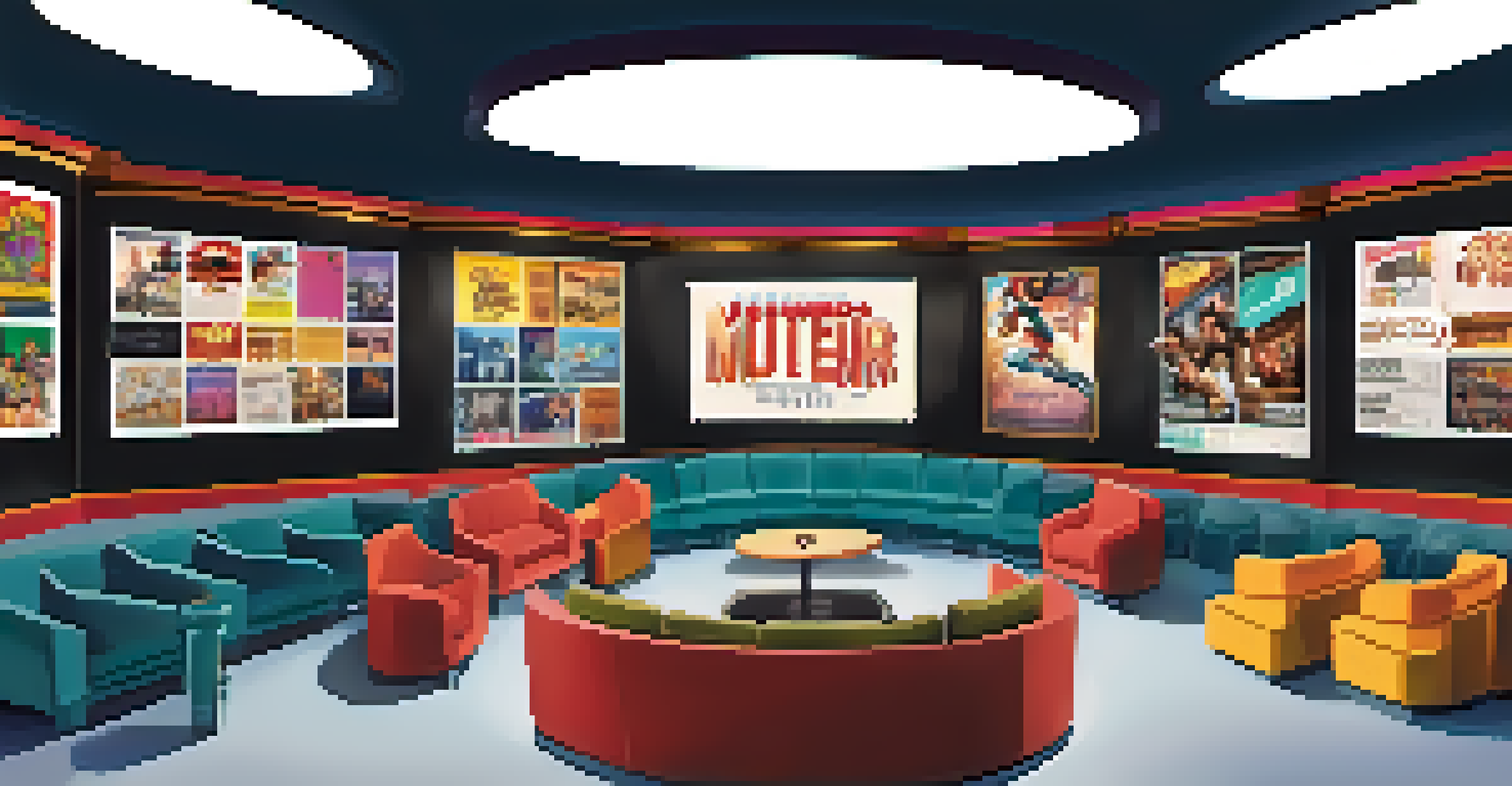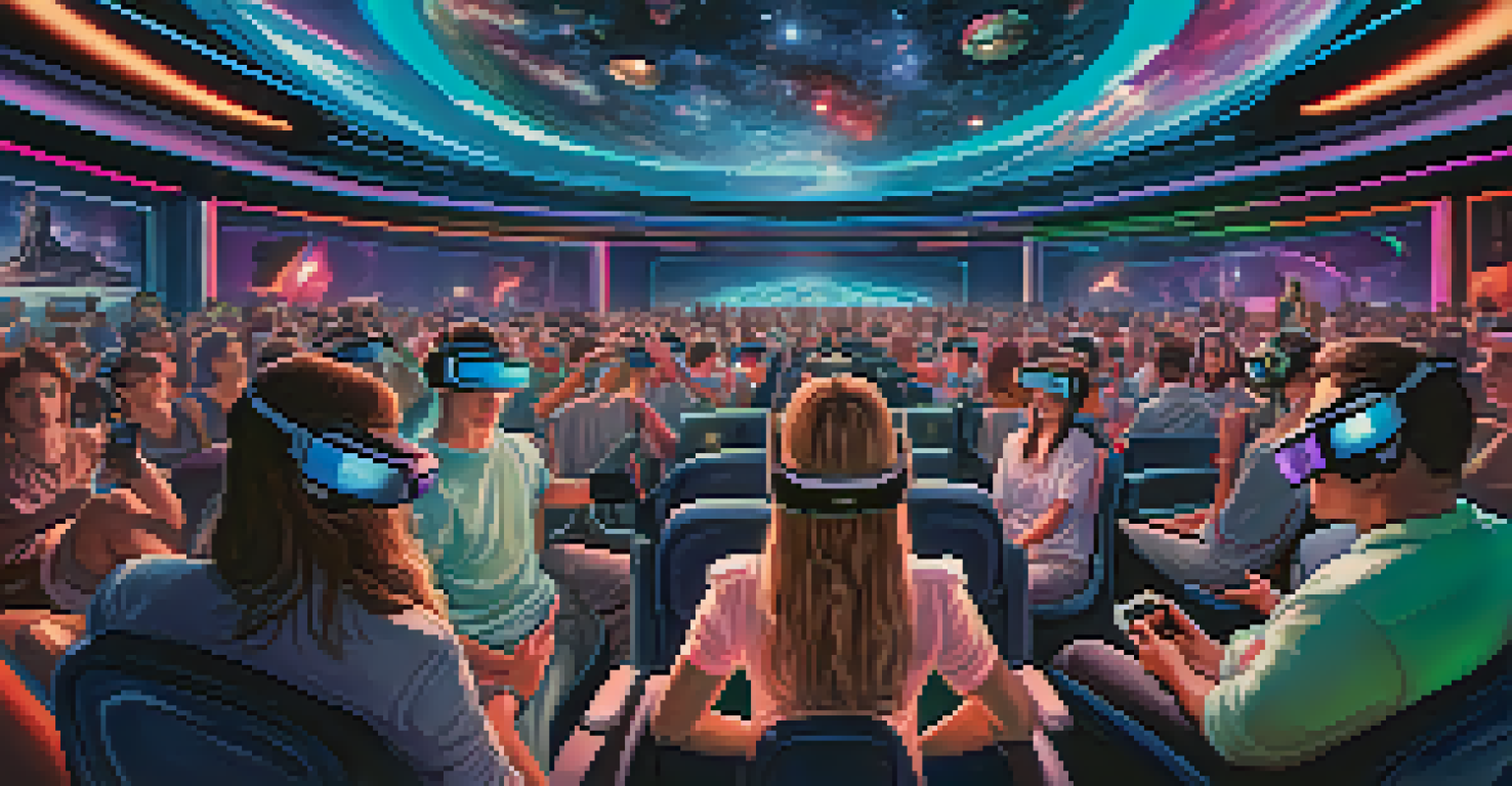From Single Screens to Multiplexes: A Cinema Evolution

The Birth of Cinema: Single Screen Theaters
In the late 19th century, cinema emerged with single-screen theaters, captivating audiences with short films. These establishments were often small, intimate spaces where families would gather to experience the magic of moving pictures. The charm of a single screen meant that every show was an event, drawing viewers into a shared experience.
Cinema is a matter of what's in the frame and what's out.
These early cinemas showcased silent films, often accompanied by live music. The simplicity of the format allowed for a focus on storytelling, where the power of visuals took center stage. Audiences were mesmerized by the likes of Charlie Chaplin and Buster Keaton, whose comedic talents transcended language barriers.
As technology advanced and film production grew, the demand for more content surged. This need paved the way for a transformation in the cinema landscape, leading to the development of larger theaters that could accommodate bigger audiences and a wider variety of films.
The Rise of Multiplexes: A New Era in Viewing
By the 1980s, multiplex theaters began to pop up, revolutionizing the way we watch movies. These venues, featuring multiple screens, allowed theaters to show several films at once, catering to diverse tastes and preferences. Suddenly, moviegoers had the luxury of choice, which transformed cinema outings into more than just a single film experience.

Multiplexes introduced the idea of showing popular blockbusters alongside independent films, appealing to a wider audience. This shift not only boosted ticket sales but also brought in varied demographics, from families to young adults seeking the latest hits. It became common for friends to debate which movie to see, enhancing the social aspect of cinema outings.
Cinema's Evolution Over Time
From single-screen theaters to modern multiplexes, the cinema experience has transformed significantly, adapting to audience preferences and technological advancements.
Moreover, the design of multiplexes often included comfortable seating, elaborate snack bars, and immersive sound systems. This focus on the viewer's experience helped to create a more enjoyable atmosphere, encouraging people to visit theaters more frequently and making it more than just a place to watch a film.
Technology Takes Over: Digital Revolution in Cinema
As we entered the 21st century, technological advancements began to reshape the cinema experience yet again. The transition from film to digital projection allowed for clearer images and sound, enhancing viewer enjoyment. Additionally, this technology made it easier for theaters to update their offerings and showcase new releases with minimal delay.
The magic of cinema is that it can transport you to another world, while also reflecting the world we live in.
The introduction of 3D films and IMAX theaters further revolutionized the cinematic experience, attracting audiences seeking more immersive entertainment. Films like 'Avatar' not only captivated viewers with stunning visuals but also demonstrated the potential of new technology to enhance storytelling. This era sparked a renewed interest in going to the movies, as people craved the spectacular experiences that multiplexes could offer.
Moreover, the digital revolution also made it easier for independent filmmakers to distribute their work. Platforms emerged that allowed smaller films to find their way into multiplexes, ensuring that diverse voices and stories could be told. This accessibility has been vital in keeping cinema vibrant and reflective of our varied culture.
The Impact of Streaming Services on Cinema
In recent years, streaming services have changed the game for how we consume films. With platforms like Netflix, Hulu, and Amazon Prime, viewers can access a vast library of movies from the comfort of their homes. This shift has posed both challenges and opportunities for traditional multiplexes as audiences weigh the convenience of streaming against the allure of a night out at the movies.
While some may argue that streaming has led to a decline in theater attendance, others see it as a way to complement the cinema experience. Many multiplexes have begun offering special screenings of popular shows and films originally released online, bridging the gap between digital and traditional viewing. This hybrid model allows movie lovers to enjoy the best of both worlds.
Streaming's Impact on Theaters
The rise of streaming services has reshaped how films are consumed, challenging traditional theaters to innovate and find new ways to attract viewers.
Furthermore, the success of films released directly to streaming services has sparked discussions about the future of cinema. With award-winning movies now debuting on these platforms, theaters are adapting to maintain relevance in an ever-evolving entertainment landscape. Audiences may find themselves enjoying the cinema experience while also appreciating the convenience of home viewing.
The Role of Cinematic Experience in Society
Cinemas have always played a crucial role in society as communal spaces for storytelling. They offer an environment where people can escape reality, engage with different cultures, and experience a range of emotions collectively. The shared experience of watching a film can foster discussions and deepen connections among friends and family.
In a time when screens dominate our lives, the cinema remains a unique venue for genuine human interaction. The laughter, gasps, and tears shared in a theater create a bond among strangers, making it a special outing that is difficult to replicate at home. It’s a reminder of the power of stories to bring people together.
Moreover, cinemas often reflect societal changes and challenges through the films they showcase. From thought-provoking documentaries to powerful dramas, movies can spark important conversations and encourage social change. As multiplexes continue to evolve, their role in shaping and reflecting culture remains vital.
Challenges Faced by Modern Multiplexes
Despite their successes, modern multiplexes face numerous challenges in today’s entertainment landscape. Increased competition from streaming platforms has forced theaters to rethink their strategies, from ticket pricing to movie selection. Keeping audiences engaged requires constant innovation and adaptation to ever-changing consumer behavior.
Additionally, the impact of the COVID-19 pandemic has left a lasting mark on the cinema industry. Many theaters struggled to reopen and maintain operations amidst restrictions and safety concerns. As audiences gradually return, multiplexes must prioritize health and safety while also offering a compelling reason for viewers to choose the theater over home viewing.
Cinemas as Community Spaces
Cinemas serve as vital communal spaces that foster shared experiences and discussions, reflecting societal changes through the stories they tell.
Furthermore, the rise of streaming has led to a shift in how films are marketed and released. Studios are exploring hybrid release strategies, where films premiere simultaneously in theaters and online. Multiplexes must navigate this new landscape, finding ways to attract audiences while competing with the convenience of streaming.
The Future of Cinema: Blending Tradition with Innovation
As we look ahead, the future of cinema seems to lie in striking a balance between tradition and innovation. Multiplexes are exploring new technologies, such as virtual reality and enhanced sound systems, to provide unique experiences that cannot be replicated at home. By embracing these advancements, theaters can attract audiences eager for the next big thing.
Moreover, there is a renewed focus on creating immersive experiences that go beyond just watching a film. Some multiplexes are incorporating themed events, interactive screenings, and gourmet dining options to enhance the overall experience. These innovations aim to turn a simple movie night into a memorable outing.

Ultimately, the evolution of cinema from single screens to multiplexes reflects our changing relationship with storytelling. By adapting to new trends and embracing the power of technology, theaters can continue to be a relevant and cherished part of our cultural landscape for years to come.